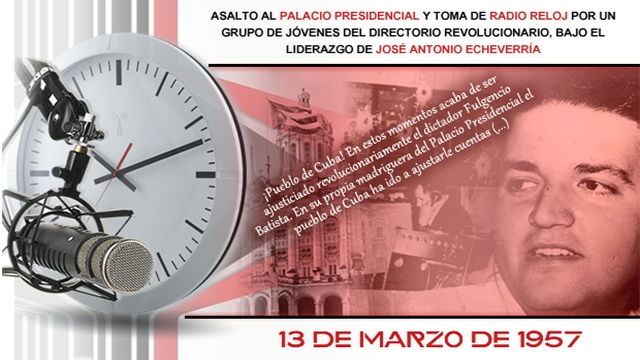
THE ASSAULT ON THE PRESIDENTIAL PALACE AND THE TAKEOVER OF RADIO RELOJ
This March 13 marks the 65th anniversary of the assault on the Presidential Palace and the occupation of the Radio Reloj radio station in Havana.
These were simultaneous actions of the struggle waged in this case by members of the Revolutionary Directorate headed by José Antonio Echeverría, who in turn was the President of the Federation of University Students, FEU, in the great educational center of the country and of the Cuban capital in particular.
The assault on the Presidential Palace was aimed at trying to surprise and execute the dictator who had unleashed, after the coup d'état carried out on March 10, 1952, a great repression against the people during the five years he had been in power and had murdered a great number of young revolutionaries.
In turn, the occupation of Radio Reloj was aimed at letting the people know what was taking place in the Presidential Palace and in addition to the news given by the announcers, José Antonio Echeverría broadcast a harangue which remained unfinished when the station was abruptly taken off the air.
In the Palace, several of the combatants were able to reach the presidential office located on one of the sides of the second floor, but the dictator had fled by an unknown staircase, not registered in the plans, which allowed the communication of his office with the upper part of the building.
It was not possible for the revolutionary combatants to reach the third floor because they had to go up a wide staircase without any protection and they were besieged by the attack of the Palace garrison.
Even several of those who participated in the assault were shot by Batista's soldiers.
Meanwhile, when the transmission of Radio Reloj was interrupted, José Antonio Echeverría and the small group that had occupied the station decided to leave the place to go to the University of Havana where they planned to maintain the leadership of the revolutionary struggle in the Cuban capital, once the physical elimination of the dictator had been consummated.
When the car in which José Antonio was traveling was moving along the side street of the University of Havana, it suddenly encountered a patrol car of the Batista police.
José Antonio quickly got out of the car wielding his gun but was killed by the shots fired by the members of the patrol car....
The attack to the Presidential Palace did not end in the expected success but it did contribute to highlight the strength of the university student youth in their struggle against the Batista dictatorship.
After the triumph of the Revolution, Fidel on several occasions, especially in the acts carried out on the anniversaries of that historical event, commented on what happened in Havana on March 13, 1957 and also highlighted aspects of the life and work of José Antonio Echeverría.
In the very first year of the Revolution, in 1959, on March 13, events were held at the Presidential Palace and the University of Havana in which Fidel spoke, who also on that day had gone to the Cárdenas cemetery to pay tribute to José Antonio Echeverría.
Several years later, exactly in 1965, on the university steps in Havana, Fidel described March 13 as a peak day, a luminous day in the life of our country.
And in 1997, on the 40th anniversary of the assault on the Presidential Palace, Fidel also said:
"I must say that the attack on the Palace on March 13 was an act of extraordinary audacity and courage, since the capital of the republic was full of pursuers, military units, armored cars, tanks, aircraft; the enemy's reactions were unpredictable".
Fidel also assured when summing up the transcendence of the assault on the Presidential Palace and the seizure of Radio Reloj, on March 13, 1957 by the members of the Revolutionary Directorate:
"Those are historical events that are never forgotten and will never be forgotten..."